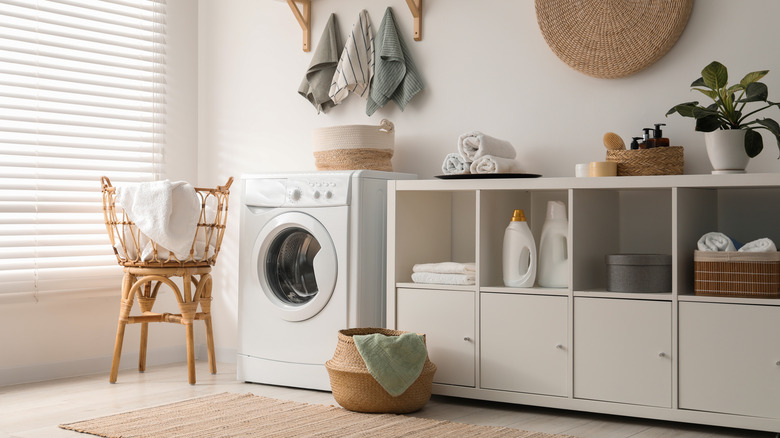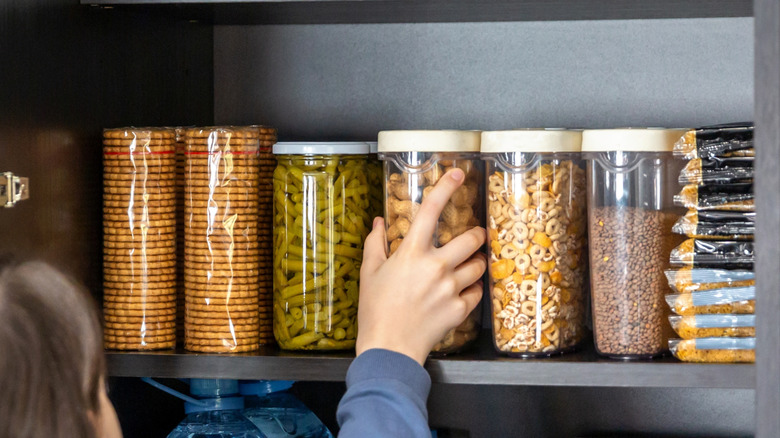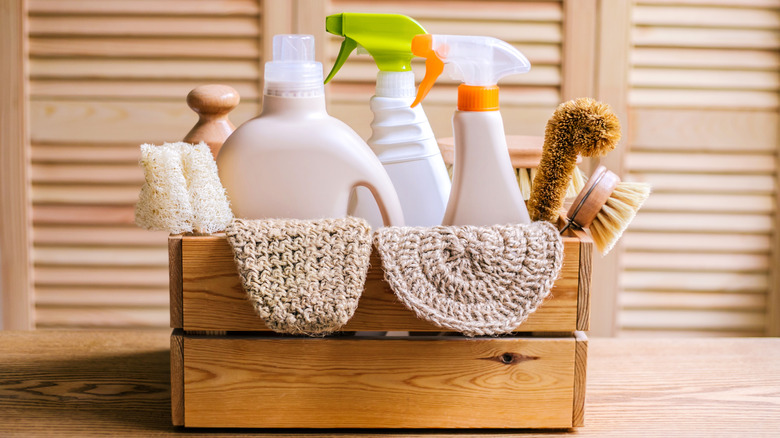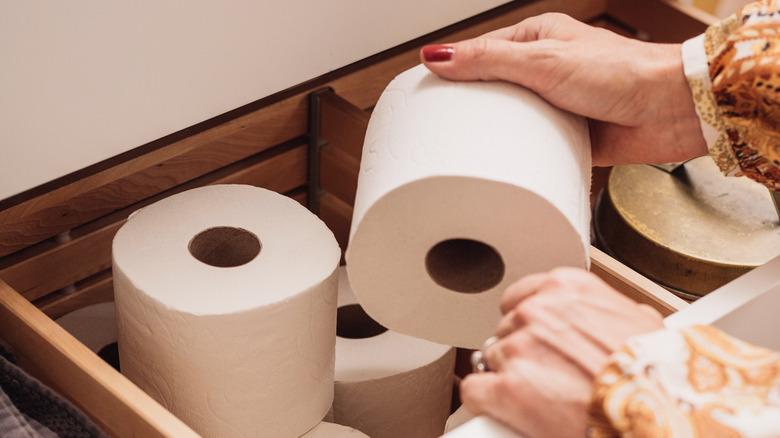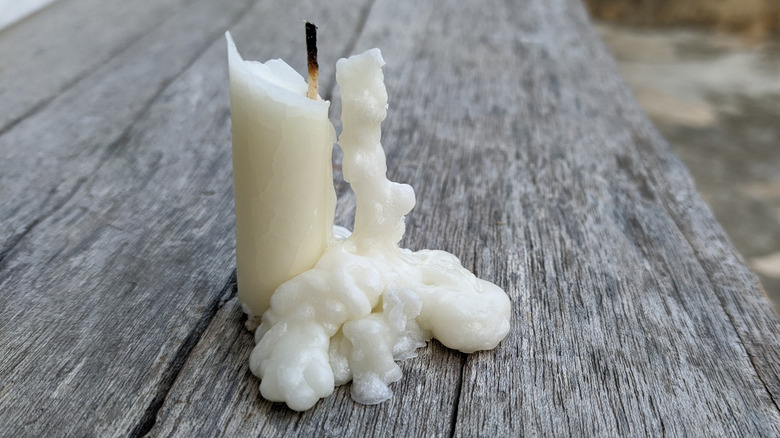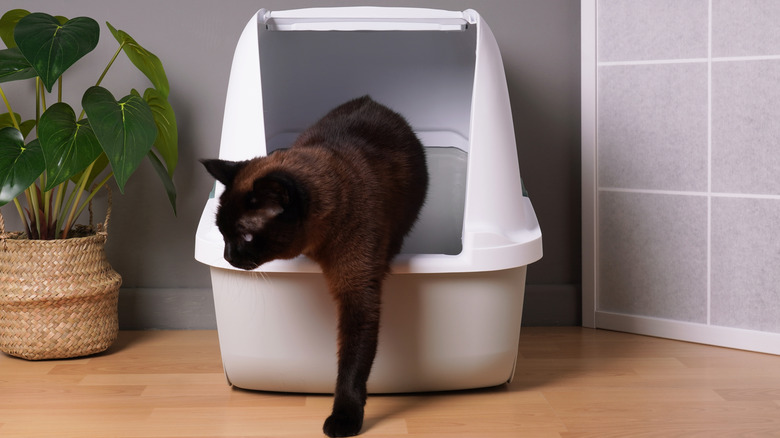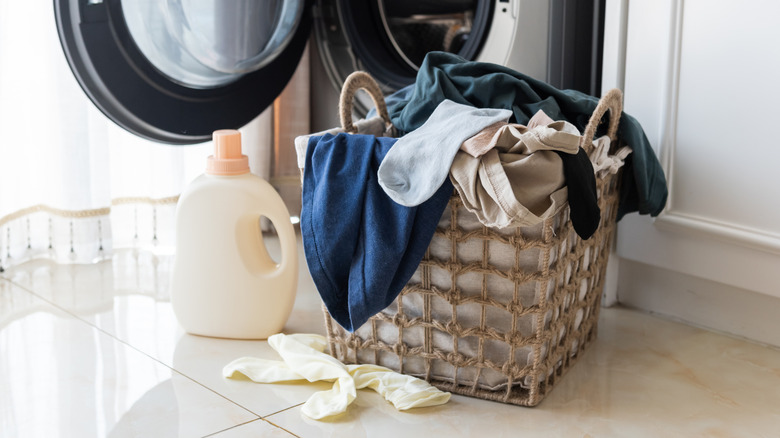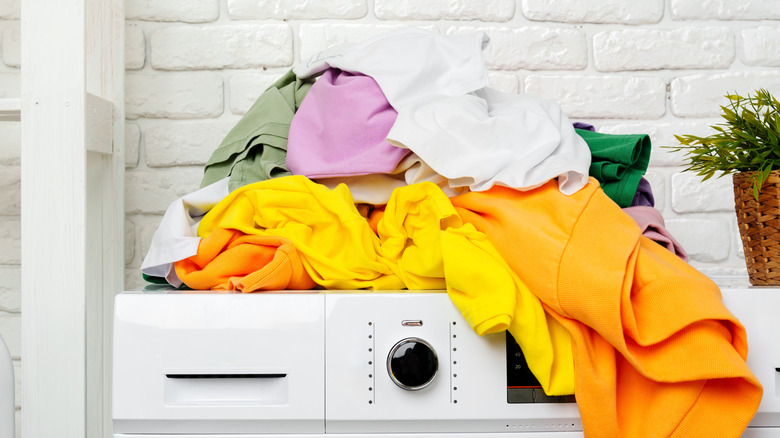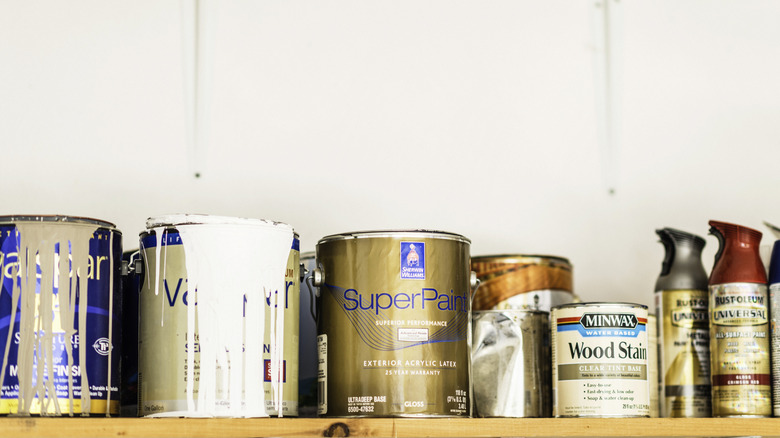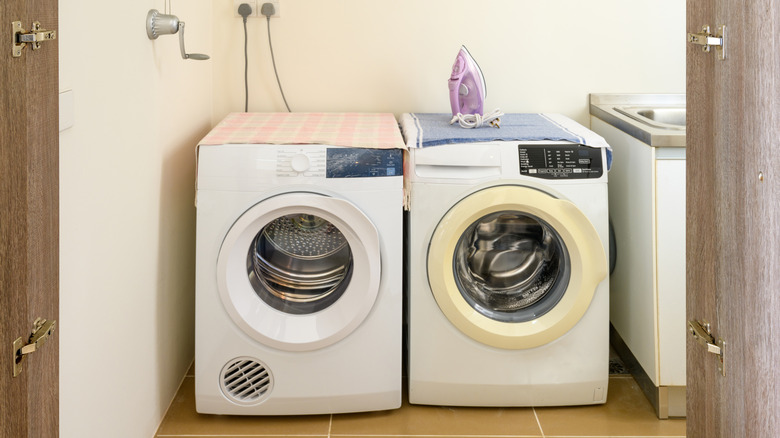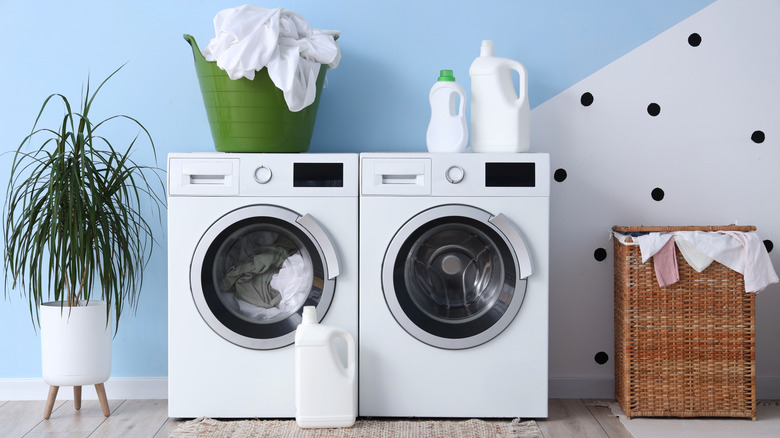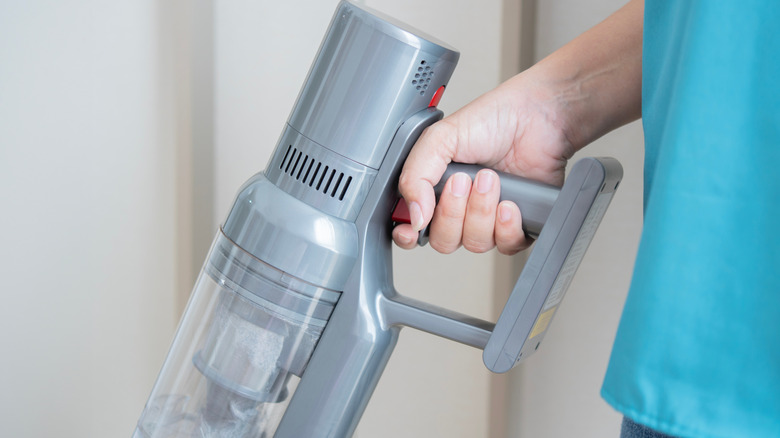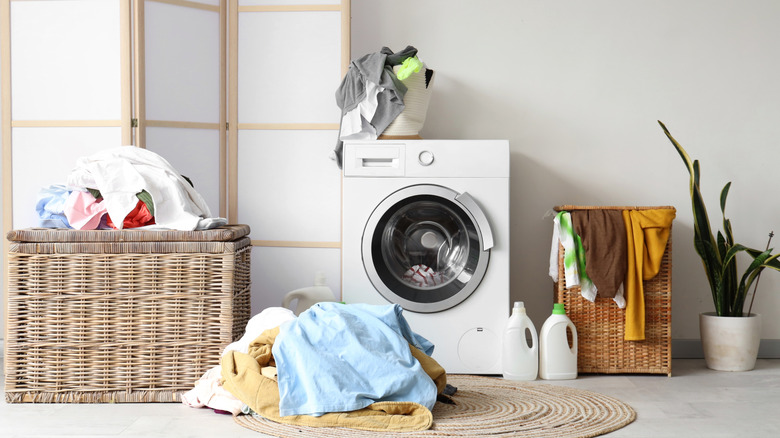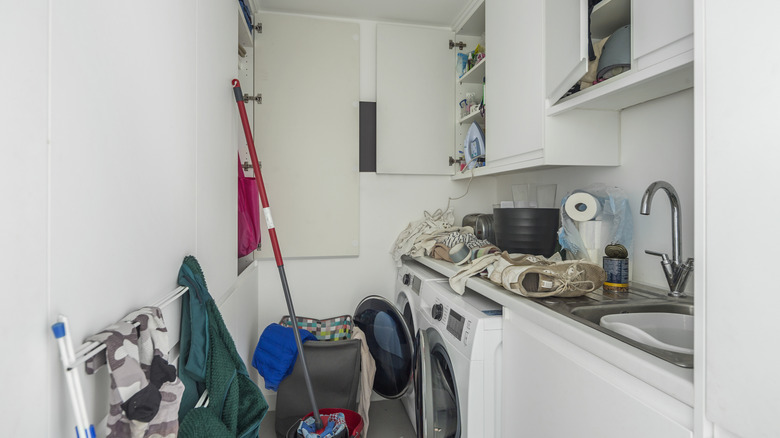14 Storage Mistakes You Might Be Making In Your Laundry Room
We may receive a commission on purchases made from links.
Your laundry room may seem like a convenient space for extra household storage. After all, those extra shelves and cabinets might feel inviting, but the conditions inside a laundry area are far from ideal. The heat from dryers, constant humidity, plus heavy machine vibrations create a recipe for damage, mold, and even fire hazards. Items that might seem perfectly fine to keep in the laundry room can actually deteriorate much faster in this environment, costing you money and creating unnecessary hazards.
Remember that your laundry room should serve as a functional space, a place designed for washing, drying, and folding, not as a storage hub for everything that you own. A box on top of the dryer can block airflow, while misplaced cleaners can spill or leak during a wash cycle. Plus, by understanding what doesn't belong in your laundry room and how to properly store items, you can make laundry day more efficient.
In the long run, avoiding a few common mistakes can save you time, money, and stress, plus you'll be able to enjoy a cleaner, more organized laundry room. If you don't know where to start, the good news is that small adjustments can make a big difference. To help get you started, here are some common laundry room storage mistakes, plus smarter alternatives.
Food and pantry items can spoil fast
Food and pantry items such as sealed packages or canned goods may not last their full shelf life in the laundry room. Boxes of cereal or pasta can soften and invite pests like ants or mice, while cans exposed to moisture may rust, contaminating the food inside and speeding up their spoilage. It is essential for pantry staples to always be kept in cool, dry spaces with steady temperatures, which is something that the laundry room definitely isn't.
Instead of parking overflow groceries near the washer, carve out space in a kitchen pantry or hallway cabinet. Use small organizer trays or bins to keep items sorted and easy to find. If you must store food outside the kitchen, choose bins with secure lids, like Storeganize's Airtight Storage Containers, that block out both moisture and pests. Keeping pantry staples in a cool, dry, and stable environment not only prevents waste but also maintains hygiene in a room that already struggles with dampness and odors.
Cleaning supplies don't mix well with humidity
While detergents and bleach seem at home in the laundry room, storing large quantities of cleaning products can be risky. If they are stored on top of the units, the constant heat and vibrations from washers and dryers can cause bottles to loosen or leak over time. In some cases, fumes from harsh chemicals can even linger in the warm, enclosed space, creating both respiratory concerns and a higher risk of fire if exposed to heat from the dryer. These leaks can also potentially damage your washing machine in the long run.
A smarter approach is to designate a cabinet or nearby utility closet for bulk cleaners, keeping them cool and away from appliances. If safety is a concern, a child-proof spot like GreatMeet's Locking Wall Mount Cabinet can provide access without clutter. You can still keep a small, daily-use supply of detergent or fabric softener on this cabinet, but avoid overcrowding or stacking multiple containers that could spill or mix in ways that create bigger hazards.
Humidity makes paper towels and toilet paper unusable
Paper goods are great household items to buy in bulk to save money, but not if you store them in the laundry room. While it may seem convenient to tuck bulky packs of toilet paper, paper towels, or tissues onto an empty shelf near your washer and dryer, the reality is that this space is one of the worst environments for them. Moisture in the air slowly seeps into the fibers, causing rolls to warp, go damp, or even grow mildew before you ever open the package. Heat from the dryer can accelerate the problem, leaving paper products unusable in the long run, or worse, can increase the risk of fire.
A better strategy is to store extras in a dry linen closet, hallway cabinet, a pantry, or a dedicated storage cabinet. If space is tight, invest in stackable bins with lids that keep moisture out. This simple switch protects your stockpile, saves you from wasting money on ruined paper, and ensures you always have a clean, usable roll when you need it most.
Candles can lose shape or melt
If you stash candles in your laundry room, don't be surprised if, the moment you pull them out, they end up warped or melted. Heat from dryers and humidity can soften wax, causing candles to deform, fuse together, or leave residue on surfaces, creating a mess that is difficult to clean up. Once this happens, candles may no longer fit into holders properly and are likely to burn unevenly when lit.
Instead, store candles in a cool, dark place away from temperature swings. A drawer or cabinet lined with tissue paper works perfectly. Another clever solution is to use your candles as décor in living spaces, on shelves or coffee tables, where they serve a double purpose: decorative accents that are always ready to be lit. Storing them properly means that they maintain their quality, and you'll avoid the disappointment of pulling out a warped, unusable candle.
Pet crates and supplies collect odors and bacteria
When space is limited, a laundry room may look like a good option for storing items belonging to our four-legged friends. At first glance, it seems practical. Their crates and litter boxes are often bulky, the food bags take up space, and toys and bedding can be messy. But the laundry room is one of the worst spots for these items, as they can quickly absorb odors in poorly ventilated spaces. Humid laundry environments encourage bacterial growth and trap smells that can potentially spread.
Instead, dedicate a well-ventilated corner of your home, such as a pantry or a designated pet pantry, to these items. A unit like Fimello's Dog Feeding Station and Pet Storage Cabinet gives you a dedicated spot to feed Fido and store all of his food and toys. If you need to accommodate your feline friend, a cabinet like Halitaa's Litter Box Enclosure has room for storage and gives them a discreet spot to do their business. It is also good practice to wash your pet's toys and bedding regularly and store food in sealed containers with tight lids. By separating pet essentials from the laundry room, you improve hygiene and keep both your laundry and your pet's belongings fresher.
Letting dirty or sweaty clothes linger invites mold
Tossing sweaty gym gear, wet swimsuits, or damp towels into a hamper in the laundry room and forgetting about them may seem harmless, but it's actually a recipe for mold. Laundry rooms are already warm and humid, and that combination creates the perfect environment for mildew to thrive. Moisture trapped in fabrics can start to feed bacteria, producing stubborn odors that are difficult to wash out. Left unchecked, mold spores can grow, leaving behind stains and discoloration that linger even after multiple wash cycles. Beyond damaging fabrics, exposure to mold can also create potential health concerns for your household.
To avoid these issues, treat damp clothing as a priority. Wash it as soon as possible, ideally the same day it's worn or used. If immediate washing isn't realistic, at least hang damp items in a well-ventilated space so air can circulate and moisture can evaporate until you're ready to wash them. Adding a small fan or dehumidifier to your laundry area can also help prevent mold from taking hold. If you notice any, whether on clothes or around the room, improve airflow, clean affected surfaces with a mold-fighting solution, and contact an expert if the problem seems widespread.
Don't leave wet or damp clothing on your dryer
Many people pile damp clothes on top of the dryer to deal with later, but this habit can easily backfire. When moisture gets trapped between the fabric and the dryer's surface, it can encourage rust to develop. Over time, this weakens the machine's finish and may even compromise electrical components. Once this damage occurs, it's difficult to repair and can shorten the overall lifespan of your dryer.
To avoid these problems, hang clothes on a drying rack or rod until they're fully dry. Or, place them in a ventilated laundry basket if you can't get to them immediately. Taking this small step not only protects your appliances but also helps prevent musty odors from clinging to freshly washed clothing.
Paint breaks down in fluctuating temperatures
Partially used paint cans often end up in the laundry room. However, the humidity and heat can cause the chemicals in the paint (especially if they are already opened) to degrade. Fluctuating conditions in this space shorten the shelf life of paints, making future touch-ups difficult or even impossible. Over time, the cans themselves may also rust or leak, creating a potential mess that would be a hassle to clean.
To protect leftover paint, store sealed cans in a cool, dry place such as a basement or closet with steady temperatures. For added convenience, pour smaller amounts into airtight plastic containers or glass jars and clearly label them with the paint color and the room where they were used. This makes quick touch-ups far easier. Keeping paint properly stored ensures you always have a usable supply ready for repairs or refreshes while avoiding the waste of hardened leftovers.
Irons risk falling or damage
The laundry room may seem like the perfect spot for your iron, but machine vibrations are a hidden hazard that most people overlook – even minor shaking from washers and dryers can gradually shift heavy objects left on top of appliances or shelves, and irons are particularly risky. Their solid weight, sharp edges, and pointed ends mean that a simple slide can quickly turn into a dangerous fall. A dropped iron can dent the metal surface of your washer or dryer, damage your flooring, and, most concerning of all, cause painful injuries if it lands on your foot. Beyond physical damage, the sudden impact can also shorten the lifespan of your iron.
A safer alternative is to mount a wall caddy designed for both your iron and ironing board. You can DIY your own iron storage solution, or purchase a ready-to-install option like Double 2 C's Wall Mount Iron Hanger. These caddies keep your iron secure, organized, and off surfaces that vibrate. Always allow it to cool completely before putting it away, and secure the cord to prevent tangles.
Craft supplies, photos, and keepsakes can warp
Humidity and moisture wreak havoc on paper-based items like photos, scrapbooks, or craft supplies. Materials like cardstock and specialty paper can curl or warp in damp air, while adhesives can lose their effectiveness, and markers may dry out faster. Sentimental keepsakes are particularly vulnerable in this environment, as the damp air can leave permanent damage that's difficult to reverse. Cluttered storage in a laundry room also makes it harder to keep these items organized, so they often end up getting lost or forgotten.
Instead of tucking these items into laundry room cabinets, keep them in airtight bins in a temperature-controlled closet or office. For precious pieces like old photographs or family letters, this approach not only protects them from damage but also keeps your storage organized, so you can find them when you need them. This ensures that they remain intact and ready to enjoy, rather than yellowing or sticking together in a humid laundry room corner.
Heavy objects can topple or damage machines
Laundry rooms often double as storage for bulky supplies, but placing heavy items on top of washers and dryers can be a mistake. Vibrations during wash cycles can cause these objects to shift or slide, creating a real risk of falls. A tumbling detergent jug or bin may not only dent machines, but it can also damage flooring or create spills that are difficult to clean. Worse, if a heavy container tips at the wrong moment, it could fall directly onto you, creating a safety hazard when you're loading or unloading clothes. These appliances aren't designed to act as shelving, so the added weight can put strain on the surfaces and potentially damage them.
Instead, store heavy items on sturdy shelving or rolling carts designed to handle the load. For example, Okzest's Rolling Laundry Cart has metal shelves for organizing supplies and provides an additional surface to put objects on top of. This type of setup keeps the tops of machines clear, protects your appliances, and makes it easier to grab what you need.
Cordless vacuums and similar devices need safe storage
Cordless vacuums, steam mops, and rechargeable gadgets are often left in laundry rooms for convenience. However, humidity happens to be their enemy. Moisture shortens battery lifespan and can cause rust that damages the components over time.
The ideal environment for battery-operated tools is cool and dry, ideally between 60 and 75 degrees Fahrenheit to avoid rust and overheating. So, store these devices in a hallway closet or a dedicated utility nook to extend their life. If charging stations must remain in the laundry area, then mount them on walls well away from water sources and keep cords neatly organized to minimize risk. These small adjustments can extend the life of your devices and protect your investment.
Ignoring vertical space leaves clutter everywhere
A common mistake in laundry rooms is underusing vertical space. Without cabinets or shelving above the washer and dryer, items tend to pile up on the floor, countertops, or even on top of the machines themselves. This quickly creates clutter and blocks airflow, making it difficult to move around what is often one of the smallest rooms in the house. When supplies don't have a proper home, laundry feels more chaotic, and the room's overall functionality is limited.
By thinking vertically, you can transform wasted wall space into smart storage. Install overhead cabinets or mount shelves above your washer and dryer to hold less-frequently used items. Adding wall hooks is excellent for ironing boards, drying racks, or cleaning tools, freeing up floor space and keeping essentials accessible. Even narrow wall-mounted racks can transform wasted wall space into practical storage. When used effectively, vertical space not only reduces clutter but also makes your laundry room feel larger and easier to work in.
Overstuffed shelves impedes airflow
As you're taking advantage of vertical space, it's important to be strategic about what you store on the open wall areas. It's tempting to cram laundry shelves with as many bottles, boxes, and bins as possible, but overstuffing them creates hidden problems. When shelves are packed too tightly, air circulation suffers. Overcrowded storage can block airflow and trap humidity, contributing to mold and mildew growth that makes the entire room unpleasant. It also increases the risk of things tipping over or products getting lost behind stacks of clutter. In the long run, a room meant to simplify chores becomes a source of stress.
To fix this, give your shelves some breathing room. It is good practice to regularly declutter your laundry room, keep cabinets organized with labeled bins, and avoid piling items too tightly. If possible, open a window, keep the door open, or add a fan that encourages air to move freely. An organized, airy setup not only prevents mildew but also makes it easier to see and access supplies when you need them.
